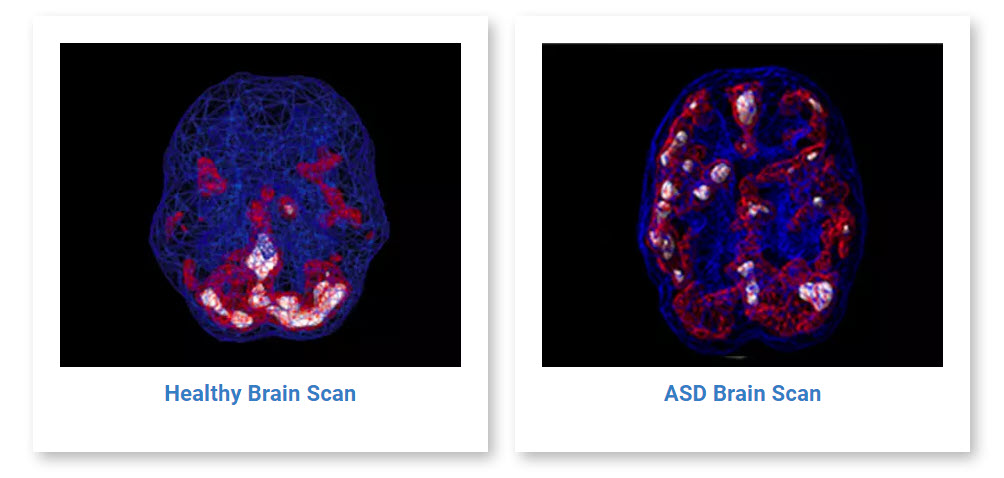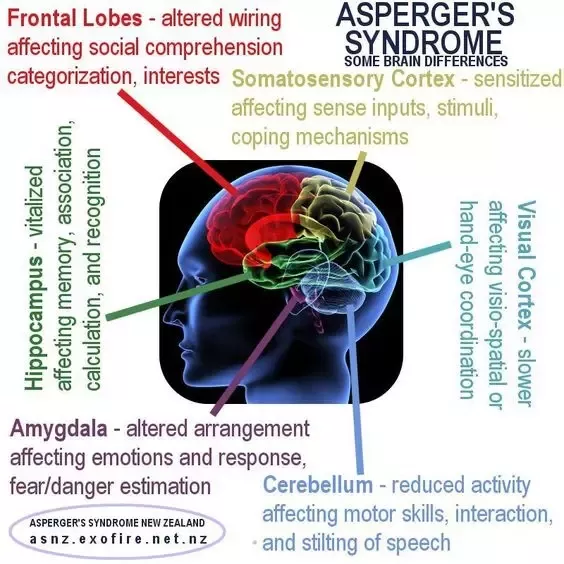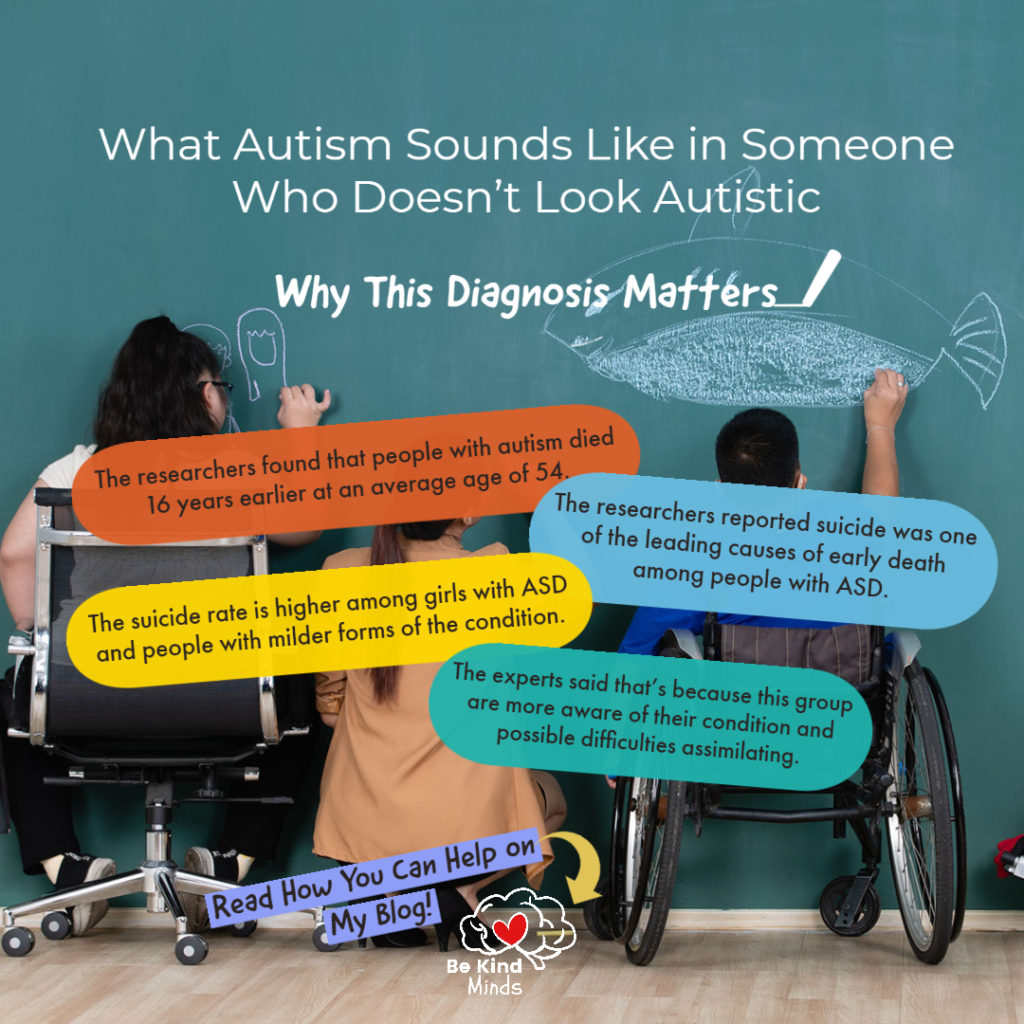You may have learned that a friend or loved one was diagnosed with Autism, but it doesn’t make sense because they ‘seem fine’… or they don’t “look Autistic”. You met kids and/or adults (likely male) who have Autism and that totally makes sense. But your friend/loved one? Are they sure they got the right diagnosis?
First, let me share with you what’s going on in the inside so you can get a foundation of why they may not look Autistic, but ‘underneath the packaging’ is the Autism that isn’t physically obvious…
A Look At Their Brain

Your friend or loved one is likely a visual learner. They see images in their mind, and when they hear a story they can see it played out in their mind like a movie. Growing up, they were likely told they didn’t listen well or when their parents went to school the teachers reported that their child was very bright, but could do better at listening.
Writing/Journaling thoughts is much easier for them to better understand the “noise” in their mind. Speaking out loud is a complicated task for them. They will likely relate to the feeling of talking as overwhelming because “thoughts collide” and it’s hard to “keep on track”. They rarely feel like what they said out loud was sufficient or accurate to how they’re really feeling. They may even suddenly “lose their train of thought” and describe what’s going on in their mind as feeling stuck or going blank. It’s the social pressure of having too many thoughts at once and feeling pressured to speak before they forget what they’re holding on to in their mind because everything moves so quickly in their mind coming and going in all directions. This is why they hyperfixate (“obsess”) on their special interests, obsessing over a specific [interesting] subject matter, everything falls inline in their mind easier. It’s also why daily-simple-predictable routines ‘feel safer’ — they take less effort in thought.
If they can have pictures or create their own pictures through drawing or painting, or creating a collage of images, that is also very helpful in being able to make sense of information and feel more satisfied in trying to express themselves to the outside world. If they are told instructions on what to do or how to do something, it needs to be broken down very specifically, or even better would be to give a visual example of what the objective is for the task… for example, an Autistic child told to get ready for school is likely to ‘get stuck’. They will either get distracted by something visual in their path on their way to do the task or when they get in their room they will be overcome with the feeling of not knowing how to get started because all the information in their mind is coming in at once. Their end result will be an emotional meltdown and they likely will struggle to explain why they are crying or having such an exaggerated response to the circumstances. Now, if you give this same child the same instruction – but with a physical picture that shows what the end result should look like, they will likely immediately get the job done with far less distraction & heightened emotion.
If they can ‘see how it’s done’ or ‘what it looks like’, they can use all the information and be better able to get it done. If they can watch a video on how to do something, they better understand how to do it themselves. They are visually motivated learners and doers.

Brain scans are incredibly helpful in better understanding the ‘why’ behind someone’s behavior. Especially for those who otherwise ‘look normal’ but don’t show up, or behave “normal”. Autism appears to affect early brain development, including the way neurons communicate with one another. However, there is not just one brain problem found in ASD, but actually 8 to 10 factors that can influence abnormal brain function. During the past few decades, Amen Clinics has seen more than 1,000 children and adults with ASD. The SPECT brain imaging studies of these patients reveal that their brain patterns tend to have high activity or low activity in the brain (even both high & low in some cases).
The areas that can be of concern and are most relevant when looking at ASD in the brain are found in the cerebellum, anterior cingulate gyrus, amygdala, frontal and temporal lobes.

- Excellent rote memory, absorbs facts easily.
- Generally performs well with the arts, maths, science, and reading (they LOVE books!).
- They love games, even as adults they find ‘stimming’ with a video game a pleasurable way to release their anxiety.
- Very common to have someone with an Austistic brain restless during a movie or TV show as they are looking up facts and trivia about actors, facts about how the movie was made.
- May be anxious and unable to cope with criticism or imperfections.
- Often victims of teasing and bullying, leading to withdrawal into isolated activities.
- Can appear clumsy and have unusual gait or stance.
- Often seen as odd or eccentric (they will often share that all their life they ‘felt different’ and others would often tell them they were “too sensitive”).
- Language often appears good but may have limited content and poor social understanding. When they talk they can have rapid-speech (especially if it’s on a topic of interest), long-winded, confused, they ‘get stuck’ or draw a blank often, jump from one subject to another, or have pressured speech like they know what they want to say but don’t know how to express it. Speaking out loud just seems like hard work.
- They can come across as having narcisstic behavior (self-interested / “know it all”) and therefore are commonly assumed as lacking empathy, also because they often absorb or dominate the conversation with references of how they feel or “info-dumping” facts and theories. Neurodivergent people share how they relate because it’s the easiest way to communicate with others that they understand (they are trying to express empathy)… but it’s assumed by many that they are dismissing the other persons emotions, and it’s this complicated social interaction that people with Autism struggle with understanding how to ‘give and take’ in a conversation.
- A subtle behavioral symptom is the tendency to repeat words or phrases.
- Poor eye contact.
- Self-harmful behaviors during an emotional meltdown (such as head-banging, intense rubbing on face or other parts of the body, hitting themselves, cutting themselves, scratching, etc)…
It’s not a lack of empathy that those with Autism manifest, it’s the inability to understand how to interact appropriately and express emotions appropriately that is often interpreted as incapable or assumed as not having love for others. The way that their brain is built and how it functions handicaps their ability to express love in the way that most “Normal” or Neurotypical people understand. They feel love, they care deeply (often to their detriment). Understanding the social norms in expressing that love is the major obstacle for them.
The Diagnosis…
Autism has historically been diagnosed far more often in male children than females (4x more likely to be diagnosed in males than females), due to social expectations being varied between males & females.
“One difficulty that researchers experience is that girls with autism seem to behave in ways that are considered acceptable—if not ideal—for girls as opposed to boys. For example, girls with autism may appear to be passive, withdrawn, dependent on others, uninvolved, or even depressed (just as boys do). They may become passionately and even obsessively interested in very specific areas (just as boys do), but they may not gravitate toward the “geeky” areas of technology or math. Sadly, in Western culture, girls who exhibit these behaviors are more likely to be ignored or bullied than diagnosed and treated.“
– “Differences in Diganosing Autism in Girls and Boys“
Several studies suggest that girls receive autism diagnoses later in life than boys, leading researchers to recognize that females manifest Autism differently than males.
“Girls and women with autism may go undiagnosed because doctors, teachers, parents and others often think of the condition as primarily affecting boys.
– “Autism’s Sex Ratio, Explained“
Autism may also look different in girls than it does in boys. Girls may have fewer restricted interests and repetitive behaviors than boys do, and may have more socially acceptable types of interests. They are also more likely than boys to mask their autism features by copying their neurotypical peers. As a result, autism may be more difficult to detect in girls even when doctors are looking for it.”
Another important statistic to keep in mind is that there is a growing concern of females with Autism being misdiagnosed with Bipolar Disorder due to the overlap of shared symptoms. Autistic ‘Meltdowns’ often look like Bipolar Mood Swings.
“To diagnose bipolar disorder, a doctor will ask questions about potential mood episodes, their severity, and how long they lasted. A psychiatrist will usually ask questions about feelings, thoughts, and experiences. Autistic people who have trouble communicating or expressing themselves often have trouble describing their feelings, thoughts, and experiences.
– MedicalNewsToday “What to Know About Bipolar Disorder & Autism“
ASD and bipolar disorder seem to cause similar gene expression patterns in the brain. For this reason, misdiagnosis does occur at times.”
Untreated, misdiagnosed, or delayed diagnosis of Autism Spectrum Disorder (ASD) is associated with higher incidences of:
- Developmental problems
- More severe symptoms
- Immune disorders (allergies, asthma)
- Diabetes
- Heart disease
- Motor disorders
- Cancer
- Obesity
- Schizophrenia
- Suicidal thoughts and behavior
How Do They Feel?
Diagnosed with Autism-Aspergers at the age of 35 has allowed Carrie Beckwith-Fellows to explore the world again from a new perspective. Aware that a late diagnosis can cause issues with identity, relationships, and perception, she has become an advocate for others diagnosed with Aspergers as adults (often referred to as “Aspies”).
Christine M. Condo wrote an editorial in The Washington Post sharing her experience with Aspergers (aka “High-Functioning Autism”)
“I have high-functioning autism, and this means that I usually look normal on the outside. But I’m here to tell you that I am fundamentally different on the inside. By the time I hit adulthood, I learned to hide my autism to avoid unintentionally upsetting or insulting neurotypical people (our word for non-autistic). If I was standing next to you waiting for an elevator, I would make small talk and smile and you wouldn’t know I’m autistic.
“This is purposeful and requires significant intellectual investment, akin to taking an exam or solving a problem. I wish I could shout from the rooftops: You have no idea how hard I have to work to appear this way!
“Some neurotypical people try to relate to people with autism by saying things like, “I don’t like large parties either,” or “I can’t stand it when there’s a loud TV in the room.” I have no doubt this is true, but these neurotypical experiences are not like my autistic ones.
“Imagine having the acuity of your senses turned up to 11. Imagine being keenly aware of every single element of your environment, all the time, especially those you normally, reflexively ignore. Imagine that every time you walk out your front door, it is like being forced to walk too close to a wall of spikes that constantly threaten to impale you.
“Even now, in my 40s, after a lifetime of observing people and practicing social niceties, I still fail in some social situations because my social performance is not instinctive, but rehearsed, based on a mental library of appropriate responses I select in real time. Autistic people learn to be good guessers, but we never really know if our responses are appropriate. We live in a state of perpetual social anxiety, always in danger of saying or doing the wrong thing.
“Sometimes people tell me I don’t “look” autistic (whatever that means). I am trapped in what I call the Autistic Paradox, too autistic to function comfortably in a neurotypical environment, but too apparently “normal” to get the sensory accommodations and solitude I need.
“If someone tells you they are autistic, it means they are under sensory assault while working unbelievably hard to appear normal to you. Please don’t say, “I would never have known you were autistic.” This is not a compliment. It is a validation of a fake self at the expense of the real one. Instead, something like, “That must take an enormous effort,” or “How can I make this easier for you?” would be much more appreciated.
Or better yet: “I have no idea what that must be like. Could you tell me more?”
[Read Her Full Article “You Don’t Look Autistic: The Reality of High-Functioning Autism“]
How Can I Help Them?
Those with ‘High-Functioning Autism’ (Aspergers) are incredibly sensitive. They often find themselves stumbling into ‘Shame Spirals’ due to exaggerated emotional responses to a Neuro-typical dominated world. Because most of their life is spent being told they are ‘too sensitive’, they are locked in a body that has a life-sentence of always overreacting and having to constantly strategize how to participate in the world while at the same time emotionally protecting themselves from the stress of that interaction.
Be Supportive and Respectful of Their Routines
Routines are sacred because predictability is their understanding of what feels ‘safe’. Change is unbelievably hard for them. If they know what to expect, and they can choose and feel safe in choosing when, and how long to participate, that helps lower the amount of stress they experience.
Be Patient When They Speak Out Loud & Don’t Be Afraid of Asking Them to Try Again to Explain Something
Speaking out loud is really hard for them, even if it appears effortless. Visual expressions are much easier, like writing down their thoughts or creating a visual representation of their thoughts feels more satisfying as they try to put their thoughts and feelings into something tangible for others.
When Asking Them to Do Something, Be Specific & Attach Images When Possible
Especially if it’s something that’s uninteresting, tedious, or is likely to trigger one of their sensory issues, they will need a visual example of what the end result should look like or visual motivation to complete the task. Simplify the instructions into easy small steps, and maybe even introduce a reward that relates to a special interest of theirs.
They Need To Feel Safe
If they appear ‘stuck’ in thought, if they shutdown and are minimally responsive, create an opening that allows them to feel like they have an easy and safe out from this task. Maybe they only have to participate for 15min, or maybe this task can be accomplished closer to home. Be willing to compromise in a way that they can feel a greater sense of safety and that will help them feel safe to open up to you in return.
*When they feel relaxed, they are more open to getting curious to try new things, and expand their threshold of what is comfortable to them. If they feel restricted or forced into something, that is likely to trigger a meltdown or persuade them to isolate and pull further back from you.*
Autism is formally diagnosed as a spectrum because the way it manifests in everyone will vary. Some will have “the look” and others will not, and many of those who don’t ‘look Autistic’ will go undiagnosed until adulthood when the masking begins to fail due to the damage from the internal stress from masking.
The condition is mistakenly thought of as linear because some psychiatrists and medical professionals will illustrate to patients that their ‘level of Autism is high or low’. The amount of Autism is the same, the more accurate distinction is to attribute the ‘high or low’ as the level of IQ. The comprehension or intellect in how to manage the symptoms and the ability to mask in public. This is also often referenced to how much dependent assistance you will need or how well you will be able to function on your own as an adult. The misconception is the amount of disruptive symptoms of Autism – the assumption from the ‘high functioning’ is that it’s fewer, and the consequence of this misunderstanding is that too many “high functioning” Autistics suffer in silence because they are assumed as not needing the support. They need the same amount of support, but the support will be different for the specific type of Autism.
The reality is that they feel it all the same as those who are considered “low-functioning”. They experience the same inwardly, they just manifest outwardly as more “normal” because their IQ has allowed them to figure out how to escape societal bullying.
“The researchers found that people with autism died 16 years earlier at an average age of 54. Adults with the condition and learning disabilities died more than 30 years earlier than people without autism at an average age of 39.5 years. Adults with autism and without a learning disability died on average 12 years earlier, at 58. The condition affects how people communicate and relate to others, and it influences how they make sense of the world around them.”
– WebMD – “People With Autism Tend to Die Younger“
“The study findings were recently published in the British Journal of Psychiatry. It’s the first time definitive research has been done on the mortality rate of people with autism. Fournier said that’s because until two decades ago autism diagnosis was uncommon and it was considered a disorder that only affected children.
– Healthline – “Why People with Autism Die at a Much Younger Age“
“The researchers reported suicide was one of the leading causes of early death among people with ASD.
“The suicide rate is higher among girls with ASD and people with milder forms of the condition.
“The experts said that’s because this group are more aware of their condition and possible difficulties assimilating.
“In addition, bullying can be a daily occurrence for people with ASD. Anxiety and depression are common responses to such treatment. Both of those mental health stresses are leading factors in suicide.”
One of the best ways to help your Autistic friend/loved one…
Be willing to continue learning about Autism with them. Learn out loud. If one of the ways you have committed to supporting them is making some personal changes in how you interact with them, when you catch yourself behaving in a way you are trying to change – correct yourself out loud. When you learn something new about Autism, share that out loud. Share with them the books you’re reading, the video you watched, the article you came across. What did you learn from that content?
Because social interaction is such a struggle for them to understand – they are constantly working on their own personal development to feel safe interacting with “normal” people in this world, the less they have to assume about others – the less stress they feel. In every possible way you feel comfortable sharing out loud to them your thoughts, the safer they will feel interacting with you. Help them understand what to expect. Help them understand how you feel. Be gentle with their extra sensitive emotions (brutal honesty and criticism is not one of these helpful ‘out loud’ statements btw). Help them believe that you are a safe person to be with because it’s not all on them to figure out how to interact socially, you are also willing to learn about how they experience the world and you are committed to trying your best to be a support in navigating this world with them in a way that feels safe and comfortable. 🙂 Learning out loud is a visual way for them to understand that. If you can do this, consistently, and create an opening that feels safe to learn together, you’ll find your relationship will grow and strengthen and become easier and easier over time. 🙂
If you find this post meaningful to you, please feel free to share it with others. If you are also connected to the “Aspie” or Autism world and have thoughts of your own to add, please add your comment below! 💚☺️

